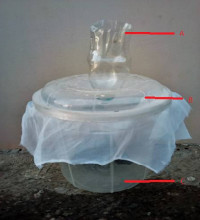Parasites associated with synantrophic flies in selected locations within Kaduna Metropolis, northern Nigeria
http://dx.doi.org/10.4314/njpar.v40i2.13
Keywords:
pathogenic parasites, sanitary practices, Infectious agentsAbstract
Flies are important transmitters of infectious agents and parasitic diseases of man and animals. Synanthrophic flies are so abundant in the tropics especially in areas with sub-standard environmental sanitary conditions. Flies were collected with a specially designed improvised trap of transparent plastic bucket about 10 cubic litres capacity with rotten pieces of meat used as bait inside the bucket within selected locations. A total of 848 flies were collected from six locations categorized according to socio-economic income status using a locally designed trap (Plate 1). Four species of flies namely: Chrysomyia albiceps, Chrysomyia chloropyga, Musca domestica and Musca sorbens were collected in the different locations. The highest fly abundance recorded 258(30.4%) while the least recorded was 177(21.0%). A total of 172 parasites were isolated using standard parasitological technique (floatation and sedimentation). The recorded parasites were cyst of entamoeba, hookworm ova,Ascaris lumbricoides ova, Strongyloides stercoralis, Hymenolepsis nana, Taenia spp. The most prevalent parasites were from the low income class (54.0%) followed by medium income class (28.4%) then the high income class (17.4%). The parasites isolated were from the external and internal body surface of the flies. The present study demonstrates the potential of synantrophic flies as vector of pathogenic parasites to humans. Therefore, unsanitary conditions which provide breeding sites for the flies should be discouraged through proper advocacy on proactive sanitary practices and personal hygiene.
References
Nmorsi, O. P.G., Ukwandu, N. C. D. and Agbozele, G. E. 2006. Detection of some gastrointestinal parasites from four synanthropic flies in Ekpoma, Nigeria. Journal of Vector Borne Diseases, 43(9): 136-139.
Olsen, A. 1998. Regulatory action criteria for filth and other extraneousmaterials. III. Review of flies and foodborne enteric diseases. Regulatory Toxicology and Pharmacology, 28: 199-211.
Ugbogu, O. C., Nwachukwu, N. C. and Ogbuagu, U. N. 2006. Isolation of Salmonella and Shigella species from house flies (Musca domestica ) in Uturu, Nigeria. African Journal of Biotechnology, 5(11): 1090-1091.
Howard, J. 2001. Nuisance flies around landfill pattern of abundance and distribution. Waste Management Research, 19: 308-313.
Che-Ghani, B. M., Oothuman, P., Hashim, B. B. and Rusli, B. I. 1993. Patterns of hookworm infections in traditional Malay villages with and without JOICFP Integrated Project in Peninsular Malaysia, 1989. Collected papers on the control of soil transmitted helminthiases, Vol. V. APCO, Tokyo, pp. 14-21.
Getachew, S., Gebre-Michael, T., Erko, B., Balkew, M. and Medhin, G. 2007. Non-biting cyclorrhaphan flies (Diptera) as carriers of intestinal human parasites in slum areas of Addis Ababa, Ethiopia. Acta Tropica, 103:
-94.
Keiding, J. 1986. The house fly biology and control. Vector Control Series, WHO/VBC/86/937: 1-63.
Ahmed, A. B. 2011. Insect vectors of pathogens in selected undisposed refuse dumps in Kaduna town, northern Nigeria. Science World Journal, 6(4): 1597- 6343.
Schmidth, G. D. and Roberts, L. S. 2000. Foundations of Parasitology, 6th Edition.
Bouamama, L., Lebbadi, M. and Aarab, A. 2007. Bacteriological analysis of Periplaneta b Americana L. (Dictyoptera; Blattidae) and Musca domestica L. (Diptera; Muscidae) in ten districts of Tangier,Morocco.
African Journal of Biotechnology, 6(17), pp. 2038- 2042.
Adeyemi, O. and Dipeolu, O. O. 1984. The numbers and varieties of bacteria carried by filth flies in sanitary and unsanitary city area. International Journal of Zoonoses, 11(2): 195-203.
Olajide, J. S. Oyelade, O. J. and Ogunniyi, T. A. 2018. Phoretic fauna and flora of domestic non-biting flies in Ile-Ife, south-western Nigeria. Journal of Entomology and Zoology Studies, 6(1): 1431-1435.
Adeyeba , O .A. and Okpala, N. 2000. Intestinal parasites and bacterial pathogens carried by common filth houseflies in Ibadan, Nigeria. African Journal of Medical and Pharmceutical Sciences, 4: 53-63.
Mawak, J. D. and Olukose 2006. Vector potential of houseflies (Musca domestica) for pathogenic organisms in Jos, Nigeria. Journal of Pest, Disease and Vector Management, 7: 418-423.
Adentan, O. E. 2015. Assessment of parasites pathogens of Musca domestica invading eating houses in Jos, Plateau State, Nigeria. Proceedings of the International Academic Conference for sub-Sahara
African Transformation and Development, 3(1): 12-13.
Oguniyi, T.A. B., Olajide, J. S. and Oyelade, O. J. 2015. Human intestinal parasites associated with non-biting flies in Ile Ife, Nigeria. Journal of Medical and Biological Science Research, 1(9): 124-129.

Downloads
Published
How to Cite
Issue
Section
License
Copyright (c) 2023 Nigerian Journal of Parasitology

This work is licensed under a Creative Commons Attribution-NonCommercial-NoDerivatives 4.0 International License.




